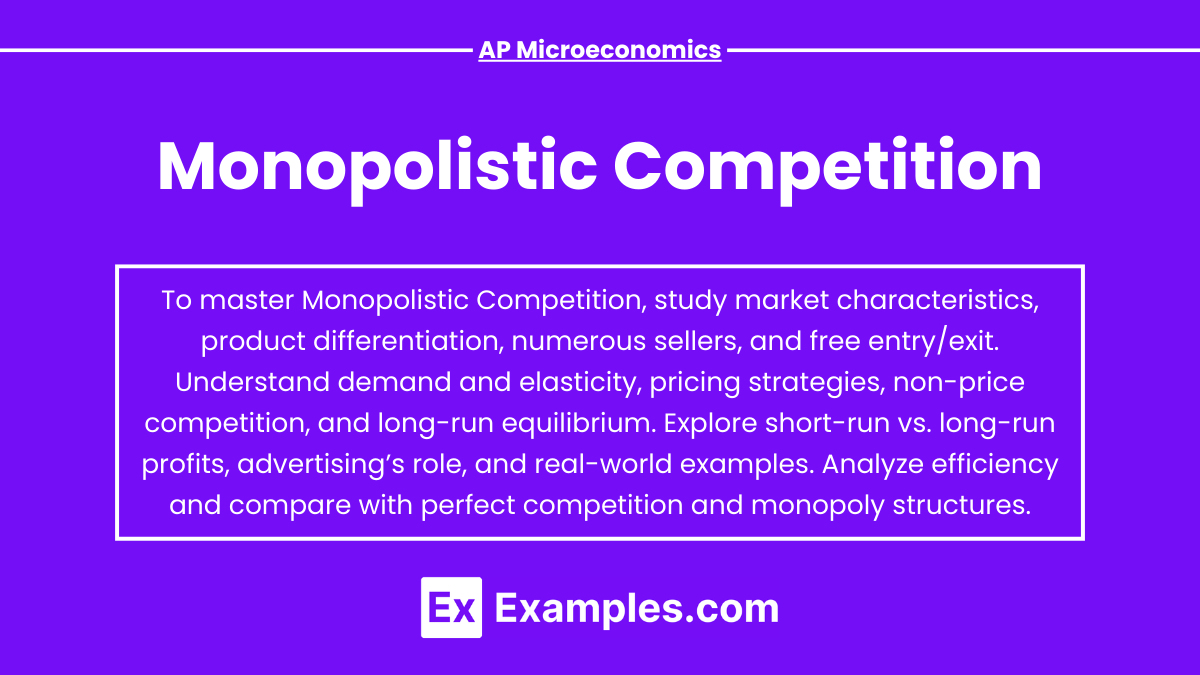Monopolistic competition is a key market structure studied in AP Microeconomics, blending elements of both perfect competition and monopoly. It features numerous firms that offer differentiated products, allowing each to have some degree of pricing power. This structure emphasizes product variety, innovation, and non-price competition, such as advertising and branding. Understanding monopolistic competition is essential for AP Microeconomics students, as it mirrors many real-world industries where businesses compete by distinguishing their offerings while enjoying limited market control.
Free AP Microeconomics Practice Test
Learning Objectives
By studying monopolistic competition, you should understand its defining characteristics, including product differentiation, numerous sellers, and free entry and exit. Learn to analyze short-run and long-run equilibrium, recognizing how firms maximize profits where marginal revenue equals marginal cost and how normal profits are achieved in the long run. Differentiate monopolistic competition from other market structures like perfect competition and monopoly. Additionally, grasp the implications of non-price competition, excess capacity, and the impact on allocative and productive efficiency. Apply these concepts to real-world examples to demonstrate practical understanding.
Monopolistic competition is one of the four primary market structures studied in microeconomics. It combines elements of both perfect competition and monopoly, featuring many firms that sell differentiated products. Understanding monopolistic competition is crucial for the AP Microeconomics exam, as it helps explain real-world market behaviors where firms have some degree of market power.
1. Definition of Monopolistic Competition
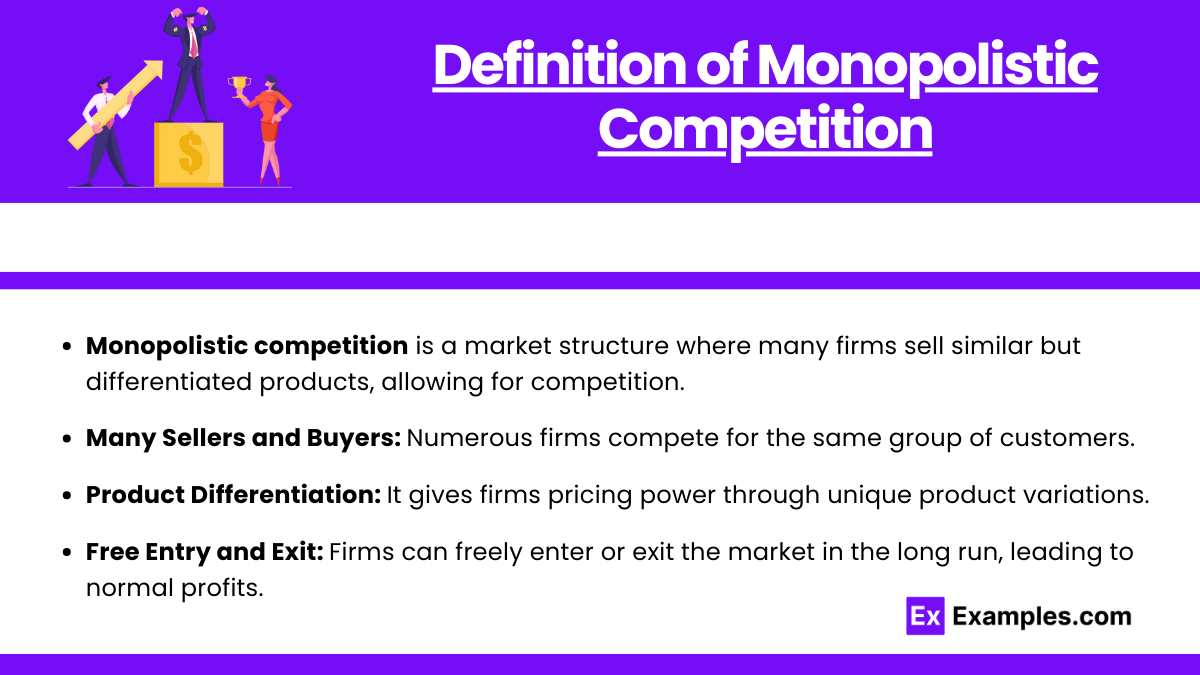
Monopolistic competition is a market structure characterized by:
Many Sellers and Buyers: Numerous firms compete for the same group of customers.
Product Differentiation: Each firm offers a product that is slightly different from others, allowing for some control over pricing.
Free Entry and Exit: Firms can freely enter or exit the market in the long run, leading to normal profits.
Independent Decision-Making: Each firm makes its own decisions regarding pricing and output without collusion.
2. Key Characteristics
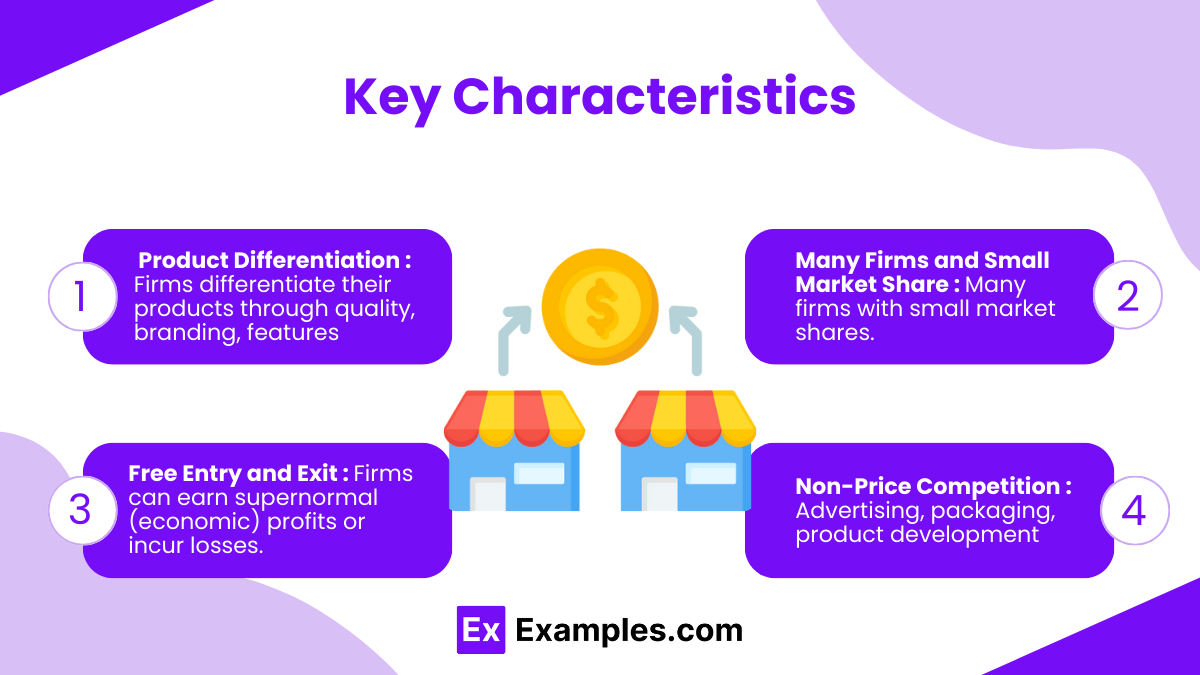
a. Product Differentiation
Nature: Firms differentiate their products through quality, branding, features, or customer service.
Purpose: Differentiation creates a perceived difference in the eyes of consumers, allowing firms to have some pricing power.
Examples: Restaurants offering unique cuisines, clothing brands with distinct styles, or smartphones with unique features.
b. Many Firms and Small Market Share
Number of Firms: The market comprises many firms, each holding a relatively small market share.
Implication: No single firm can influence the market price significantly, but product differentiation allows some control over price.
c. Free Entry and Exit
Short-Run vs. Long-Run:
Short-Run: Firms can earn supernormal (economic) profits or incur losses.
Long-Run: Free entry and exit drive firms to earn normal profits as supernormal profits attract new entrants, increasing competition.
d. Non-Price Competition
Methods: Advertising, packaging, product development, and customer service.
Objective: Differentiate the product further to build brand loyalty and reduce price elasticity.
3. Differences from Other Market Structures
a. Monopolistic Competition vs. Perfect Competition
Feature | Perfect Competition | Monopolistic Competition |
|---|---|---|
Number of Firms | Many | Many |
Type of Products | Homogeneous | Differentiated |
Entry and Exit | Free | Free |
Price Control | None (Price Taker) | Some (Price Maker) |
Non-Price Competition | Minimal | Significant |
b. Monopolistic Competition vs. Monopoly
Feature | Monopolistic Competition | Monopoly |
|---|---|---|
Number of Firms | Many | One |
Type of Products | Differentiated | Unique |
Entry and Exit | Free | High Barriers |
Price Control | Some | Significant |
Non-Price Competition | High | Low |
4. Short-Run Equilibrium in Monopolistic Competition
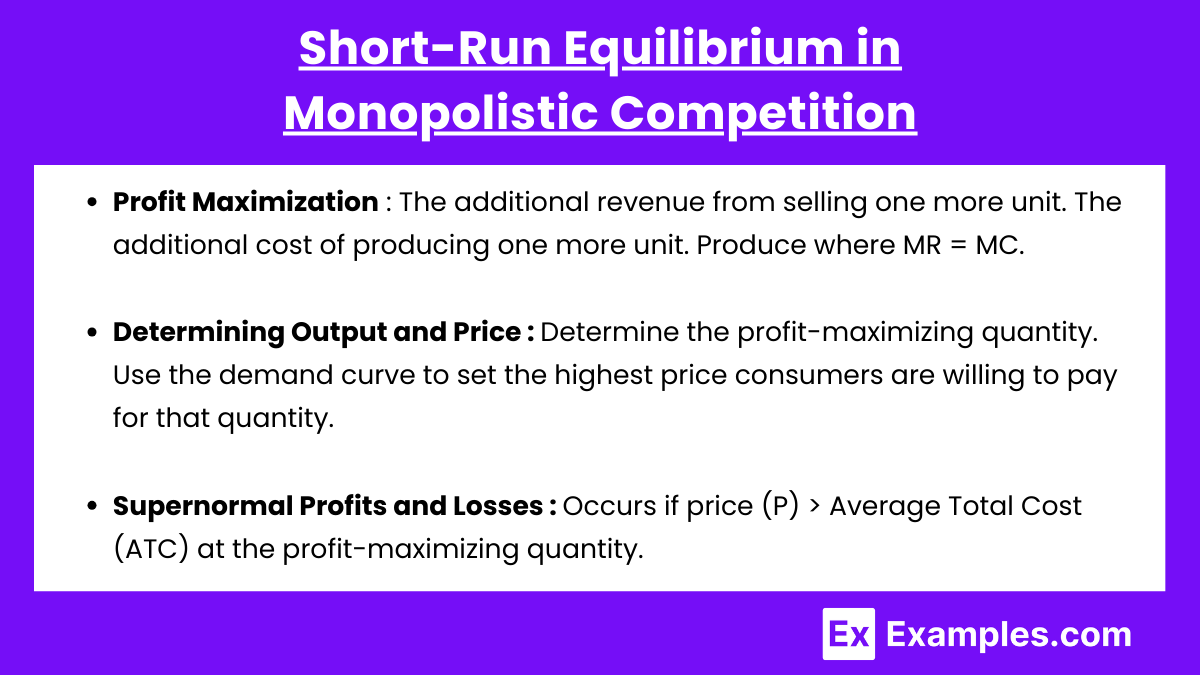
a. Profit Maximization
Marginal Revenue (MR): The additional revenue from selling one more unit.
Marginal Cost (MC): The additional cost of producing one more unit.
Profit Maximization Rule: Produce where MR = MC.
b. Determining Output and Price
Find MR = MC: Determine the profit-maximizing quantity.
Set Price: Use the demand curve to set the highest price consumers are willing to pay for that quantity.
c. Supernormal Profits and Losses
Supernormal Profit: Occurs if price (P) > Average Total Cost (ATC) at the profit-maximizing quantity.
Loss: Occurs if P < ATC at the profit-maximizing quantity.
Normal Profit: Occurs if P = ATC.
d. Diagram Explanation
Figure: Short-Run Equilibrium in Monopolistic Competition
Demand Curve (D): Downward sloping due to product differentiation.
Marginal Revenue Curve (MR): Lies below the demand curve.
Marginal Cost Curve (MC): Upward sloping.
Average Total Cost Curve (ATC): U-shaped.
Equilibrium: The intersection of MR and MC determines Q*. The corresponding P* is found on the demand curve.
Profit: If P* > ATC at Q*, the firm earns supernormal profit.
5. Long-Run Equilibrium in Monopolistic Competition
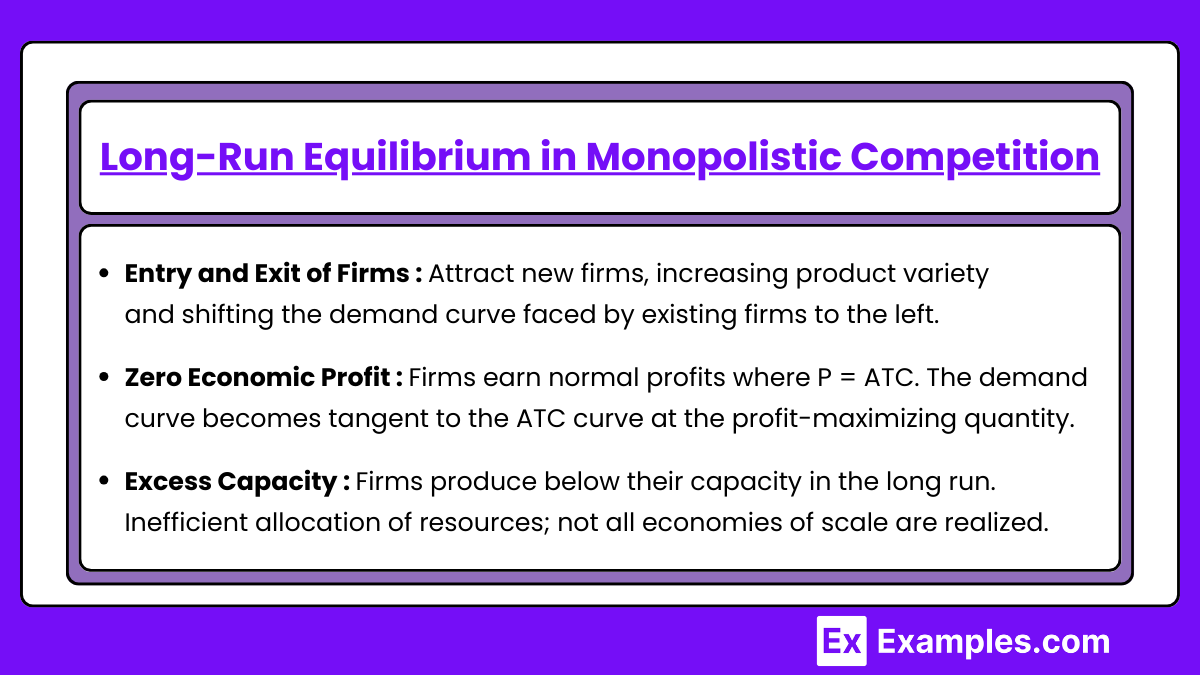
a. Entry and Exit of Firms
Supernormal Profits: Attract new firms, increasing product variety and shifting the demand curve faced by existing firms to the left.
Losses: Cause firms to exit, decreasing product variety and shifting the demand curve to the right.
b. Zero Economic Profit
Long-Run Outcome: Firms earn normal profits where P = ATC.
Adjustment: The demand curve becomes tangent to the ATC curve at the profit-maximizing quantity.
c. Excess Capacity
Definition: Firms produce below their capacity in the long run.
Implication: Inefficient allocation of resources; not all economies of scale are realized.
Reason: Differentiation leads to a downward-sloping demand curve, preventing firms from producing at minimum ATC.
d. Long-Run Equilibrium Diagram
Figure: Long-Run Equilibrium in Monopolistic Competition
Demand Curve (D): Tangent to ATC at the equilibrium point.
Marginal Revenue (MR) and MC: Intersect at the profit-maximizing quantity where P = ATC.
Result: Normal profit, zero economic profit.
Examples
Example 1. Restaurant Industry
The restaurant industry is a quintessential example of monopolistic competition. Numerous restaurants operate within the same geographic area, each striving to attract customers by offering unique dining experiences. Differentiation occurs through various factors such as cuisine type (Italian, Chinese, Mexican), ambiance, pricing, menu variety, and quality of service. For instance, two Italian restaurants might coexist in the same city, but one may specialize in traditional recipes with a cozy, family-friendly atmosphere, while the other offers a modern twist with innovative dishes and a trendy setting. This differentiation allows each restaurant to have some control over its pricing and customer base despite the presence of many competitors. Additionally, the relatively low barriers to entry mean that new restaurants can enter the market easily, promoting continual innovation and diversity in offerings.
Example 2. Clothing and Apparel Brands
The clothing and apparel sector exemplifies monopolistic competition through the vast array of brands and styles available to consumers. Brands like Nike, Adidas, Zara, H&M, and countless smaller boutiques each offer distinct designs, quality levels, and brand identities. Product differentiation is achieved through unique designs, branding strategies, material quality, and marketing campaigns. For example, Nike differentiates itself with its focus on athletic performance and innovative technology in sportswear, while Zara emphasizes fast fashion and trendy styles at affordable prices. This differentiation allows each brand to cultivate a loyal customer base and exercise some degree of pricing power. The ease of entry into the fashion industry, especially with the rise of online retail platforms, further sustains the monopolistic competitive environment by enabling new brands to emerge and compete.
Example 3. Hair Salons and Barbershops
Hair salons and barbershops operate under monopolistic competition by offering personalized and differentiated services. Each salon or barbershop may distinguish itself through factors such as the expertise of stylists, the range of services offered (e.g., coloring, styling, treatments), pricing, salon ambiance, and customer service quality. For instance, one salon might specialize in high-end, luxury treatments with a focus on organic products and a serene environment, attracting clients willing to pay premium prices. In contrast, another might offer quick, affordable haircuts with a casual atmosphere, appealing to budget-conscious customers. The presence of many such establishments within the same area ensures competition, while differentiation allows each to target specific customer segments and maintain some control over their pricing.
Example 4. Consumer Electronics (Smartphones)
The smartphone market is a prominent example of monopolistic competition, characterized by numerous brands offering similar yet distinct products. Companies like Apple, Samsung, Google, OnePlus, and Xiaomi compete by differentiating their smartphones through design, operating systems, features, brand reputation, and pricing strategies. For instance, Apple differentiates its iPhones with a proprietary iOS operating system, a focus on premium design and build quality, and a strong ecosystem of apps and services. Samsung, on the other hand, offers a wide range of models catering to different price points and emphasizes hardware innovations like high-resolution displays and advanced camera systems. This differentiation enables each brand to attract specific consumer preferences and retain customer loyalty, even in the face of intense competition and the availability of substitute products.
Example 5. Retail Stores and Supermarkets
Retail stores and supermarkets often operate under monopolistic competition by offering a variety of products with subtle differences. Chains like Walmart, Target, Trader Joe’s, Whole Foods, and numerous local grocery stores compete by differentiating themselves through product selection, pricing, store layout, customer service, and additional services (e.g., in-store bakeries, pharmacies). For example, Whole Foods distinguishes itself by focusing on organic and natural products, appealing to health-conscious consumers willing to pay higher prices. Trader Joe’s offers unique private-label products with a quirky shopping experience, attracting customers seeking variety and novelty. Meanwhile, Walmart competes on price and convenience, providing a wide range of products at lower prices. The presence of multiple retailers within the same market ensures competition, while each store’s unique offerings and strategies allow them to attract and retain different segments of the consumer base.
Multiple Choice Questions
Question 1
Which of the following scenarios best illustrates a firm operating under monopolistic competition?
A) A local utility company providing electricity with no close substitutes.
B) A farmer selling identical wheat in a perfectly competitive market.
C) A smartphone manufacturer differentiating its products through unique features and branding.
D) A pharmaceutical company holding a patent for a unique drug.
Answer: C) A smartphone manufacturer differentiating its products through unique features and branding.
Explanation:
Option A: Describes a natural monopoly where a single firm dominates due to high barriers to entry (e.g., utility companies). This does not align with monopolistic competition, which involves many firms.
Option B: Represents perfect competition, characterized by many firms selling homogeneous products with no differentiation. Monopolistic competition involves differentiated products.
Option C: Correctly identifies a scenario of monopolistic competition. Here, numerous smartphone manufacturers offer products that are similar yet differentiated through features, branding, and design. This differentiation grants each firm some degree of pricing power, a hallmark of monopolistic competition.
Option D: Illustrates a monopoly, where a single firm controls the market due to barriers like patents. Monopolistic competition involves many firms with no significant barriers to entry.
Question 2
In the long-run equilibrium of a monopolistically competitive market, which of the following is true?
A) Firms earn supernormal profits, attracting new entrants.
B) Price equals marginal cost (P = MC).
C) Firms produce at the minimum point of their average total cost curve.
D) Firms earn normal profits, and demand is tangent to average total cost.
Answer: D) Firms earn normal profits, and demand is tangent to average total cost.
Explanation:
Option A: In the long run, supernormal profits in monopolistic competition attract new firms, increasing competition until profits are eliminated. Thus, firms do not earn supernormal profits in the long run.
Option B: Allocative efficiency (P = MC) is characteristic of perfect competition. In monopolistic competition, P > MC, indicating allocative inefficiency.
Option C: Productive efficiency (producing at the minimum ATC) is not achieved in monopolistic competition. Firms operate with excess capacity, producing below the minimum ATC.
Option D: Correctly describes the long-run equilibrium in monopolistic competition. Free entry and exit ensure that firms earn normal profits (zero economic profit). The demand curve becomes tangent to the average total cost (ATC) curve at the profit-maximizing output level, indicating no incentive for firms to enter or exit the market.
Question 3
Which of the following is a result of excess capacity in monopolistic competition?
A) Firms produce at the lowest point on their average total cost curve.
B) Firms have no control over the price of their product.
C) Firms operate with some resources unused, leading to productive inefficiency.
D) Consumers benefit from lower prices due to high competition.
Answer: C) Firms operate with some resources unused, leading to productive inefficiency.
Explanation:
Option A: This statement describes productive efficiency, where firms produce at the minimum ATC. In monopolistic competition, firms do not achieve productive efficiency due to excess capacity.
Option B: Firms in monopolistic competition have some degree of price control because of product differentiation. They are not price takers as in perfect competition.
Option C: Correctly identifies a consequence of excess capacity in monopolistic competition. Firms do not produce at full capacity, resulting in productive inefficiency because they operate below the optimal scale where ATC is minimized.
Option D: While high competition can lead to lower prices, in monopolistic competition, prices are typically higher than in perfect competition due to product differentiation and some degree of market power. Thus, consumers do not necessarily benefit from lower prices.

